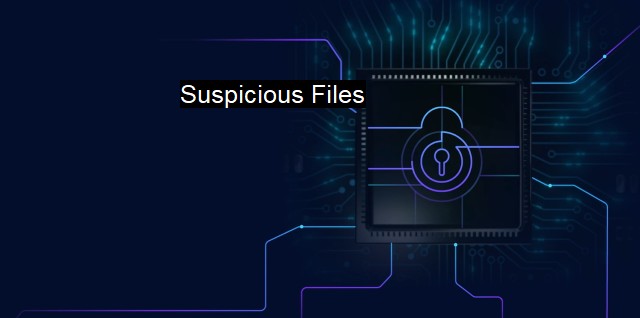What are Suspicious Files?
Uncovering Suspicious Files: Strategies and Importance in Securing Your System from Cyber Threats
"Cybersecurity is a mature but critical discipline within the field of information technology. Its significance is amplified by the proliferation of various digital threats capable of stealing sensitive information or manipulating IT systems. One such manner includes so-called "suspicious files," a term often seen in antivirus software notifications. suspicious files constitute anything that has the potential to jeopardiously alter your computer.Suspicious files often carry potential threats, such as viruses, malware, ransomware, Trojans, and worms. They are typically flagged by antivirus or anti-malware software as part of their cybersecurity function, due to an unfamiliar file signature or suspected malicious activity. Suspicious files trigger heuristic alarms, which suggests they operate differently from known benign files and therefore may comprise unknown or novel threats.
These files are usually automatically scanned by antivirus software whenever they are accessed, opened, or executed. The monitoring happens mostly in real-time, indicating that as soon as the file is opened through processes such as saving a document on the hard drive, accessing attachments in emails, and downloading items from the internet, the files are analyzed and compared against existing threat databases maintained by security-ware.
Often, the reason files are considered suspicious is due to their behaviour being out of the ordinary. Suspicious files can be either local or foreign, meaning they can originate from within the network or be transferred from an external source. Locally generated suspicious files could indicate a possible intrusion, data breach, or ongoing exploit happening bisecting network security systems. Foreign files, meanwhile, can comprise malicious payloads intended to infect the host computer or spread throughout the network.
It is important to highlight that files labelled as suspicious are not necessarily malicious. This is why most antivirus software provides options for how to deal with these files. Users might choose to delete the file, quarantine it (moving it to a secure area on the hard drive where it cannot execute or spread), disregard the alert (provided they are confident the file does not pose a risk), or permit the antivirus software to auto-resolve the issue, which often involves removal or quarantine.
A salient attribute of suspicious files is their frequent morphing or altering their code to eschew detection by signature-based threat detection methodologies. This allows them to elude security systems and evolve into several versions over time to resist human or programmatic attempts to analyse and eradicate the malicious code.
In protecting against suspicious files, organizations and individuals have several proactive strategies. These include regularly updating and patching software, investing in multi-layered security solutions offering both signature-based and heuristic threat detection, implementing robust firewalls, regularly scanning systems for vulnerabilities, taking a prudent approach to email attachments and online downloads,
Educating users about recognizing possible cyber threats, and performing regular backups of critical data.
Embracing a risk-based cybersecurity framework that tailors security measures based on the value and vulnerability of various digital assets. For instance, systems dealing with sensitive and valuable information should be subject to multiple security mechanisms, comprising intrusion prevention systems (IPS), AI-driven threat detection applications, and incident response drills.
Suspicious files serve as potential entrance points into IT systems for a range of nefarious activities from unauthorized accesses all the way to fully-fledged cyberattacks. They embody an element of the broader cybersecurity landscape that requires awareness, vigilance and strategic foresight. Neglecting the concerns posed by suspicious files might lead to catastrophic cyber events, making it profoundly essential to identify, analyse, evaluate and manage these nascent threats by using a diverse arsenal of online and offline defensive measures. This encompasses a lot from technology tools and best practices for software hygienics to personnel training and creating a culture of cross-functional cooperation to tackle the growing menace of cyber threats.

Suspicious Files FAQs
What are suspicious files?
Suspicious files are files that exhibit abnormal behavior or contain malicious code that might harm your system. They are files that antivirus software consider a potential threat or have no trustworthy origin.What should I do if my antivirus detects a suspicious file?
You should immediately move the file to quarantine or delete it. Quarantine isolates the file and prevents it from harming your system. If the file is important to you, you can submit it to the antivirus vendor for further analysis.What are some signs of a suspicious file?
Some signs of a suspicious file include random pop-ups or advertisements, slow system performance, strange messages or errors, and unauthorized changes to your desktop, settings, or system files.How can I avoid downloading a suspicious file?
You can avoid downloading a suspicious file by sticking to reputable websites and avoiding clicking on suspicious links or attachments in emails. You should also keep your antivirus software up-to-date and run regular scans on your system.| | A | | | B | | | C | | | D | | | E | | | F | | | G | | | H | | | I | | | J | | | K | | | L | | | M | |
| | N | | | O | | | P | | | Q | | | R | | | S | | | T | | | U | | | V | | | W | | | X | | | Y | | | Z | |
| | 1 | | | 2 | | | 3 | | | 4 | | | 7 | | | 8 | | |||||||